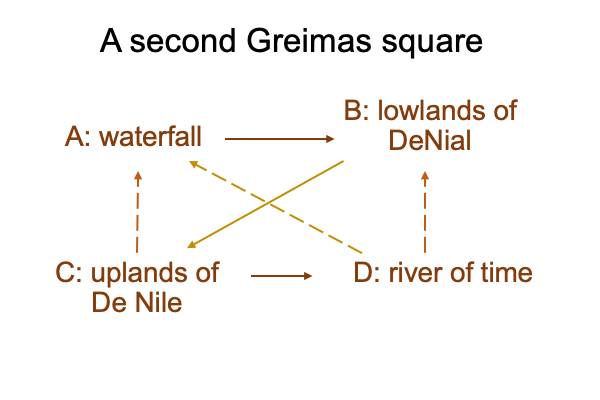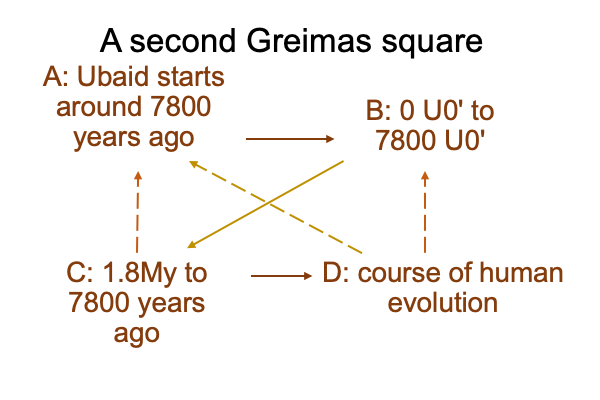0088 There are two creation stores in Genesis.
Genesis One portrays the creation of the tent (or temple) of the heavens and the earth. At the same time, using Peirce’s typology of signs, the six days of creation are signs of corresponding evolutionary epochs.
Genesis 2.4 introduces the stories of Adam and Eve. These stories are fairy tales, concerning two figures living near the start of the Ubaid. Adam and Eve are the parents, not of all humanity, but the lineage of Seth. Noah is born in the lineage of Seth. Abraham is born into the lineage of Noah. Moses is born in the lineage of Abraham. David is anointed king over the people who followed Moses. Jesus is born into the lineage of David.
0089 Remember the Greimas square?
Here is the Greimas square for the map of the Nile, imaginatively relabeled with a pencil.

0090 The waterfall is an imaginary construct, marking the location of a series of unnavigable rapids. It is the focal term (A).
The Ubaid of southern Mesopotamia is clearly manifest in the archaeological record by 5800BC. That is 7800 years ago. I denote this year as 0 Ubaid Zero Prime, that is, 0 U0′ (spoken, “Zero Uh-Oh Prime”).
Uh-oh Prime?
0091 Imagine going over a waterfall so tall that, by the time of landing, you do not remember that you went over some sort of edge, long long ago.
Yes, that sounds like 0 U0′.
0092 Perhaps, I can picture a series of rapids, where each rapid is so turbulent that one hardly remembers the previous one. Or maybe, one remembers only half of the previous turbulence. After four rapids, each lasting around two-hundred and forty-eight years, one remembers only one-sixteenth of the first rapid. After another seven-hundred and fifty years, one remembers less that one percent of the original rapid. Perhaps, people only remember the first rapid as some sort of fairy tale.
0093 The Ubaid nominally starts at 0 U0′.
The next archaeological period, the Uruk, begins around 1800 U0′.
That corresponds to seven Plutonic years.
In each Plutonic year, civilization emerges, grows, matures, becomes feeble, and descends into the underworld.
Recall, only a single Plutonic year describes the rise, growth, maturity, corruption and self-destruction of the United States of America, from 1776 to 2024.
Imagine such change seven times over.
Who could remember?
0094 The lowlands of DeNial (B) contrast with these rapids. The lowlands hit their stride in the Uruk.
The Uruk expands, in an organized fashion, into territories occupied by other Neolithic cultures. Uruk invents the pottery wheel, then the cart wheel. Uruk domesticates the donkey. Uruk invents writing. Uruk conducts long-distance trade, which is very different from traditional down-the-line exchange. Uruk builds towns. Uruk sends emissaries to distant lands. Uruk demands corvee labor and compensates with rations using standardized bowls.
Neighboring hand-speech talking cultures do what every culture does when exposed to a budding civilization with wealth and power. They mimic their neighbor. They drop the hand-talk component of their hand-speech talk. They adopt speech-alone talk. Then, they too, begin to forget the time-less world of hand-speech talk. Why? Speech-alone talk and hand-speech talk have radically different semiotic properties.
0095 Speech-alone talk is purely symbolic. Spoken words can label anything. On the map, I write the name of the river, running through Egypt, on its way to the Mediterranean, where history begins. I write the name, “DeNial”. Sure, it is a joke, of some sort. At the same time, the label shows that any spoken word can be placed anywhere, even on a map of a river, when the official name is different. Yes, we pretend that our spoken words are full of meaning, presence and message, when they really only placeholders in two arbitrarily related systems of differences, parole and langue. Spoken words fill empty slots in a network of empty slots.
Isn’t that what the structuralists have been telling the modern West for the past century?
0096 The uplands of De Nile (C) speak against the lowlands of DeNial (B).
Hand-speech talk pictures and points to its referents. So, the referent exists and the gestural-word pictures or points to the referent. Symbolic operations enter the picture only because one manual-brachial word gesture must be sufficiently distinct as to not be confused with other manual-brachial word gestures. Symbols have that character. Each symbol is distinct. Distinctiveness allows speed in communication. Manual-brachial word gestures, even though grounded in the sign-qualities of icons and indexes, are sufficiently symbolic as to support symbolic operations, otherwise known as grammar.
Hand-speech talk is fully linguistic. Hand-speech talk is grounded in the natural sign-qualities of icons and indexes. Hand talk has trained us to expect that our words refer to real things, not abstractions or made-up realities. We innately expect our words to refer to things and states of things.
0097 The river of time (D) contrasts with the uplands of De Nile (C), because it includes that short river running through the lowlands (B), just beyond the falls (A). As far as human evolution goes, De Nile (C) runs for millions of years while the entire river (D) runs only 7800 years longer. All written history occurs within that short period of 7800 years. Everyone who we know, as historical figures, live in our current Lebenswelt (B).
0098 Here is a picture of the Greimas square for the waterfall, in terms of Earth years.

